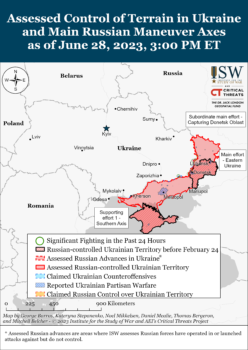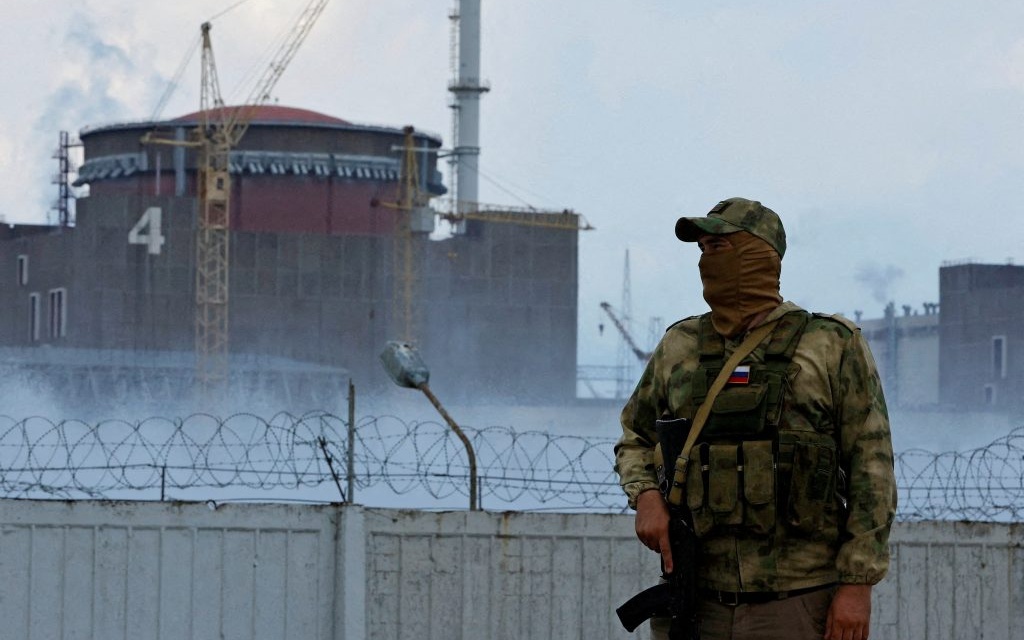A Russian soldier at the occupied Zaporizhzhia Nuclear Power Plant in southern Ukraine, August 4, 2022 (Alexander Ermochenko/Reuters)
Tuesday’s Coverage: A Drone Attack on Moscow’s Vnukovo Airport

Map: Institute for Study of War
UPDATE 1616 GMT:
Experts of the International Atomic Energy Agency say they have not yet seen any evidence of mines or explosives placed at the Russian-occupied Zaporizhzhia Nuclear Power Plant.
However, the agency said:
The IAEA experts have requested additional access that is necessary to confirm the absence of mines or explosives
In particular, access to the rooftops of reactor units 3 and 4 is essential, as well as access to parts of the turbine halls and some parts of the cooling system at the plant.
UPDATE 1256 GMT:
Another video from the Ukrainian attack on Russian-occupied Makiivka in the Donetsk region in eastern Ukraine (see 0640 GMT), apparently detonating a large ammunition depot….
This is what the explosion at an ammunition depot in occupied #Makiivka looked like from the air.
Recall that Russian propagandists claimed that the APU hit a hospital. pic.twitter.com/EqgN8Jlld4
— NEXTA (@nexta_tv) July 5, 2023
The Ukraine military said a “formation” of Russia troops was eliminated. Russian proxy officials insisted that only civilian targets were hit.
UPDATE 1232 GMT:
Speculation is circulating that, amid a purge of suspected supporters of the Wagner Group’s mini-rebellion, Deputy Defense Minister Gen. Yunus-Bek Yevkurov has been arrested.
Russian military analysts and UK military intelligence both note that Yevkurov, who hold the the title Hero of Russia, has not been seen in public since the June 23-24 rebellion. He was absent on Monday from a televised meeting attended by Defense Minister Sergey Shoygu and other senior Ministry officials.
During the rebellion, Yevkurov was in the headquarters of the Southern Military District, captured by mercenaries without a shot fired as they occupied the city of Rostov-on-Don.
Yevgurov was featured in a video speaking with Prigozhin, who demanded that the dismissal of Shoigu and Gen. Valery Gerasimov, the Chief of Staff and commander of the Ukraine invasion.
Sources close to the matter said last week that Gen. Sergey Surovikin, a former commander of the invasion and the head of Russia’s Aerospace Forces, has been detained.
UPDATE 0912 GMT:
Seeking public support for more expenditure for his Ukraine invasion, Vladimir Putin has used an 8-year-old girl and Russia’s Finance Minister in a performance for the cameras.
The Kremlin released video of Putin welcoming the girl, Raisat Akipova. Finance Minister Anton Siluanov initially missed his cue, failed to respond to Akipova’s greeting, but soon agreed to the extra funding for her home region in southern Russia.
“Excellent!” Putin responded, telling the girl, “We’ve got 5 billion roubles ($55.6 million) for Dagestan.”
There’s a new chapter in the Kremlin's post-mutiny PR offensive
Today we’re told that apart from the young girl who got her selfie with Putin, another one was apparently left heartbroken after not meeting him
Putin was so upset when he heard that he invited her to the Kremlin https://t.co/1qyHbqngTo pic.twitter.com/47u4paM7eF
— Francis Scarr (@francis_scarr) July 4, 2023
Putin also used Akipova in a call to Prime Minister Mikhail Mishustin.
The performance highlighted Putin’s emphasis on maintaining support from southern regions. Soon after the Wagner Group’s rebellion on June 24, he did a choreographed walkabout in Dagestan, with residents chosen to greet him warmly.
And… they’re squeezing every last drop out of this post-mutiny PR stunt
Over tea in the Kremlin, the girl’s father tells Putin that a replacement for him can never be found. I bet he enjoyed hearing that! https://t.co/g5UQ53p6Yi pic.twitter.com/n4fFCu8OzM
— Francis Scarr (@francis_scarr) July 5, 2023
UPDATE 0746 GMT:
On Monday morning, Novaya Gazeta journalist Elena Milashina and lawyer Alexander Nemov were on their way to a court hearing which imposed a 5 1/2-year prison sentence on the mother of two Chechen activists.
They were attacked by masked men who severely beat them with truncheons and kicked them. Nemov was stabbed. Milasheva’s head was shaved and she was doused with green paint as she lost consciousness. She suffered injuries to her head and hands.
Both are now in a Moscow hospital.
Milasheva described the assault to the independent Russian outlet Meduza:
We flew into Grozny, got in a taxi, and drove about 500 meters. We passed the Sever military base and three cars carrying at least 10 to 15 people overtook us. They threw the taxi driver out of the car and threw us facedown. They tried to tie my hands behind my back and Sasha [Nemov] was stabbed — he was bleeding.
We drove a bit further and then stopped. They dragged us into a ravine and started beating us. They understood their capabilities and limits very well, they knew what they were doing. They were in a hurry and harshly demanded the passwords for our devices.
Sasha was brutally beaten, they told him directly: “Defend people at home, there’s no need to defend people here.” They shaved [my head]. They threatened to cut off my fingers and tried to break them, but they didn’t break. I have a concussion but no fractures.
Then they left: they told us to count to a hundred, facedown on the ground. Sasha and I lay down, counted, and then got up. They ran back over, hit us hard, and then told us to count to a hundred again. And that was it.
Nemov echoes Milasheva’s account and adds:
They said that they had given me a warning — when they put me under surveillance. “That was a warning, and now we’re going to kill you.” They put me on my knees and put a gun to the back of my head. They demanded that I beg them for mercy.
UPDATE 0724 GMT:
“European intelligence sources” say Russia plans to send more Chechen fighters and convicts to frontlines to bolster forces depleted by Ukraine’s counter-offensive and the rebellion of Wagner Group mercenaries.
Vladimir Putin is trying to avoid another full mobilization, following widespread resistance to its initial mass call-up of men last September.
The Kremlin announced the end of the mobilization on October 31, but has reportedly pursuing covert measures to send men to Ukraine.
UPDATE 0704 GMT:
In a possible easing of hostilities less than two weeks after the Wagner Group’s mini-rebellion against the Kremlin, Russian authorities are absolving Wagner head Yevgeny Prigozhin of financial responsibility for damages.
The administration of Rostov-on-Don, the city briefly occupied by Wagner, said it will not pursue 92.5 million rubles (about $1 million) for damages.
The Russian outlet Fontanka claimed that Russian officials have returned more than 10 billion rubles and hundreds of thousands of US dollars in cash as well as five gold bars to Prigozhin on Sunday.
The money and gold had been seized from Prigozhin-affiliated facilities in St. Petersburg during the rebellion.
UPDATE 0640 GMT:
The US-based Institute for the Study of War assesses that Ukraine’s counter-offensive is pursuing the attrition of Russian manpower and equipment, a strategy that “conserves Ukrainian manpower at the cost of a slower rate of territorial gains”.
The head of Ukraine’s National Security and Defense Committee, Oleksiy Danilov, wrote on Tuesday:
At this stage of active hostilities, Ukraine’s Defense Forces are fulfilling the number one task – the maximum destruction of manpower, equipment, fuel depots, military vehicles, command posts, artillery and air defense forces of the russian army. The last few days have been…
— Oleksiy Danilov (@OleksiyDanilov) July 4, 2023
Danilov summarized, “More destroyed means more [area] liberated. The more effective the former, the more the latter. We are acting calmly, wisely, step by step.”
Ukraine’s military said late Tuesday that its attacks eliminated Russian units in Makiivka on the eastern front in the Donetsk region.
“As a result of the effective fire impact of the units of the defence forces, another formation of Russian terrorists in the temporarily occupied Makiivka ceased to exist,” the armed forces said in a statement.
Makiivka is 15 km (10 miles) east of Donetsk city, the center of the Russian proxy administration.
A large explosion is reported in occupied #Makiivka, Donetsk region. Local media published a video of the explosion. pic.twitter.com/g5TydjUalL
— NEXTA (@nexta_tv) July 4, 2023
On the southern front, Valeriy Shershen, the spokesperson for the Southern Military Command, said Ukrainian troops advanced by up to 2 km (1.2 miles) towards the port city of Berdyansk.
On Monday, Deputy Defense Minister Hanna Maliar reported the liberation of another 65.8 square km (25.4 square miles) of territory: 37.4 square km on the eastern front near Bakhmut, and 28.4 square km on the southern front.
The Institute for the Study of War evaluates, “The current pace of Ukrainian operations is not indicative of a stalemate or evidence that Ukraine cannot retake large areas.”
ORIGINAL ENTRY: Ukraine President Volodymyr Zelenskiy has again warned that Russia may be planning to sabotage the Zaporizhzhia Nuclear Power Plant in the south of the country.
Citing Ukrainian intelligence, Zelenskiy said on Tuesday that Russian troops have placed “objects resembling explosives” on the roofs of several buildings on the complex, the largest in Europe.
The world sees – and cannot fail to see – that the only source of danger to the Zaporizhzhia nuclear power plant is Russia. And no one else.
Now we have information from our intelligence that the Russian military has placed objects resembling explosives on the roof of several power units of the Zaporizhzhia nuclear power plant. Perhaps to simulate an attack on the plant. Perhaps they have some other scenario. But in… pic.twitter.com/RWbykc72cL
— Володимир Зеленський (@ZelenskyyUa) July 4, 2023
Earlier in the day, Zelenskiy briefed French President Emmanuel Macron on Russia’s “dangerous provocations”. He and Macron “agreed to keep the situation under maximum control together with the IAEA [International Atomic Energy Agency]”.
Ukraine’s militiary cited “operational data” that “explosive devices” had been placed on the roofs of the station’s third and fourth reactors. An attack was possible “in the near future”.
They said the Russian plan was to put out the disinformation that Ukraine had attacked its own nuclear plant: “If detonated, [the explosives] would not damage the reactors but would create an image of shelling from the Ukrainian side.”
Ukraine’s Minister for Temporarily Occupied Territories, Irina Vereshchuk, urged Ukrainians living near the plant to evacuate.
She referred to the June 6 demolition of the Nova Kakhovka Dam and subsequent flooding of the Kherson region neighboring Zaporizhzhia.
Find any opportunity to leave.
Do not wait for the occupiers who, as we observed after the [Kakhovka[ hydroelectric station explosion, provided no assistance to the civilian population. I anticipate the same in this case.
Ukrainian Military Intelligence chief Kyrylo Budanov said last month that the Russian forces, who seized the complex in March 2022, had finished preparations for a potential attack by placing explosive devices near four of the six reactor buildings.
Zelenskiy followed up on June 22 with the warning that “Russia is considering the scenario of a terrorist attack”. He said last week, alongside Spanish Prime Minister Pedro Sánchez: “There is a serious threat because Russia is technically ready to provoke a local explosion at the station, which could lead to a release [of radiation].”


“There is a serious threat because Russia is technically ready to provoke a local explosion at the station, which could lead to a release [of radiation].”
Why? The radiation would spread into territory Russia holds. It doesn’t make any sense.